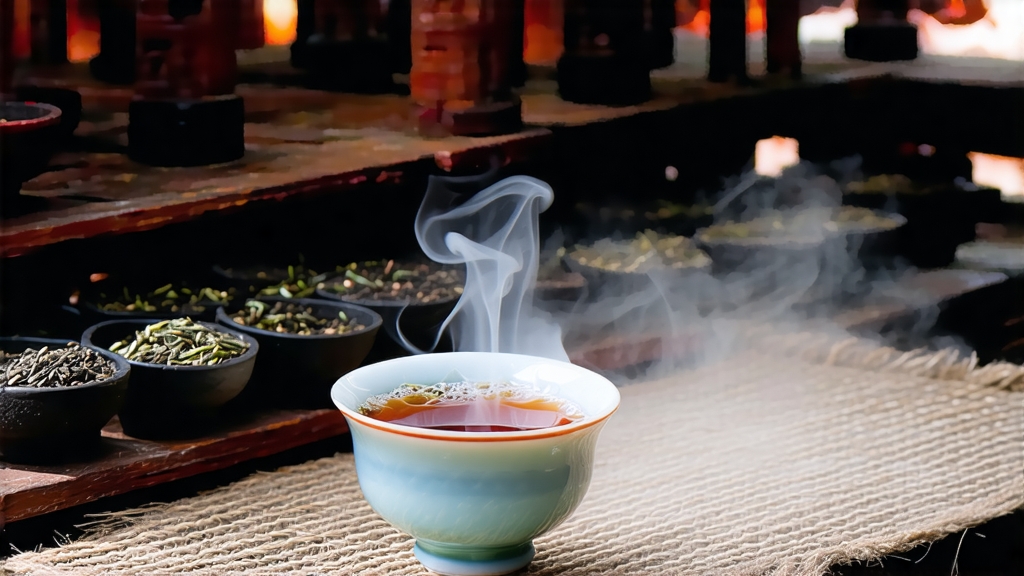
Ask most tea lovers to name the oldest black tea on earth and they will pause; mention Lapsang Souchong, however, and eyes light up with the romance of campfires in distant China. Hailing from the granite gorges of Tongmu Guan in the Wuyi Mountains of north-west Fujian, Lapsang Souchong is not merely a tea—it is the progenitor of every red-black leaf that later travelled the globe. Its Chinese name, zhengshan xiaozhong, literally means “small-leaf variety from the original mountain,” a geographical stamp that Chinese law now protects as zealously as Champagne in France. To sip it is to taste the 17th-century moment when green tea met smoke, coppery oxidation met pine resin, and the world’s first fully fermented tea was born.
History: From Misty Pass to Global Cup
Local legend places the birth around 1568, when a passing army commandeered Tongmu village during the late-Ming tea harvest. To dry the piled leaves before they spoiled, farmers rushed them over fresh pinewood fires; the resulting aromatic brew so delighted the next merchant caravan that orders returned the following spring. By 1604 Dutch traders had ferried the novel “Bohea” (Wuyi) tea to Europe, where it filled the cups of London coffee-houses, Catherine of Braganza’s royal court, and eventually the rebellious Boston dockworkers who tipped chests of it into the harbour. Thus the pine-smoke that began as accident became signature, and Lapsang Souchong became the template for every subsequent black tea—Keemun, Assam, Ceylon—exported along the Tea-Horse Road and across the Indian Ocean.
Terroir: Why Only Tongmu Can Be “Zhengshan”
The Wuyi range is a UNESCO biosphere reserve whose mineral-rich, weathered tuff soils drain sharply into the Jiuqu (Nine-Bend) River. At 600–1,200 m elevation, morning fog lingers until noon, diffusing sunlight into a soft, blue-green glow that forces the tea bush to synthesize more amino acids and volatile oils. Surrounding forests of Masson pine and cedar infuse the air with resinous terpenes; these same woods later fuel the smoking sheds, creating a closed aromatic loop impossible to replicate elsewhere. Chinese regulation restricts the geographical indication to 68 square kilometres—any leaf smoked beyond this zone must legally drop the coveted “zhengshan” prefix.
Cultivars: Three Leaf Architectures
Lapsang Souchong is traditionally made from the indigenous xiaozhong (small-leaf) strain of Camellia sinensis var. sinensis, notable for its narrow, slightly serrated blade and high ratio of bud to leaf. Within the GI zone growers now recognise three sub-clones:
• Cai Cha – the original mixed population, giving complex floral top notes.
• Rou Gui Xiao Zhong – a cinnamon-scented sport that adds sweet-spice depth.
• Jiu Qu Mei – “nine-bend eyebrow,” whose curved leaves tolerate heavy smoke without turning bitter.
Each cultivar is plucked in a fleeting three-day window around Qingming festival, when two leaves and a bud stand at 75 % unfurl, the cellular sap sweet yet still tender.
Craft: The Eight Steps from Leaf to Smoke
- Plucking – dawn pick, baskets lined with bamboo leaves to prevent bruising.
- Withering – spread on bamboo screens in the second-floor loft above the smoking pit; ambient heat from dying emblems lowers moisture to 60 % within four hours.
- Rolling – 45 min of machine-assisted kneading ruptures cells, releasing catechins and polyphenol oxidase.
- Oxidation – piles rest in pine-wood trays inside a humid 24 °C room; colour shifts from jade to copper within two hours, far shorter than Indian blacks because the goal is a sweet, winey base rather than malt.
- Primary firing – “sha qing” at 200 °C for three minutes halts oxidation, locking in a reddish liquor.
- Smoking – the signature step: fresh pinewood is lit, then smothered to smoulder; tea is laid on sieves one metre above, absorbing phenols and guaiacol for six to eight hours. Traditionalists repeat this on three consecutive nights, allowing a rest day in between